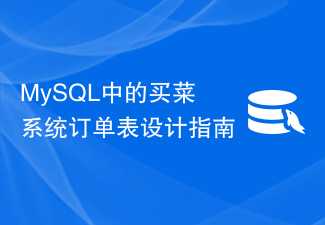 Java
Java javaTutorial
javaTutorial How to implement the Java switch grocery shopping system with flash sale function
How to implement the Java switch grocery shopping system with flash sale function
In today’s e-commerce market, flash sale activities have great market decision-making ability. In order to win market share, various merchants have implemented large-scale and high-frequency flash sales activities. For this kind of activity, implementing a relatively complete system in the background can not only ensure the stability of the system, but also win higher benefits for merchants.
This article will introduce how to implement a simple flash sale function in Java open source distributed cache, and take the switch of the grocery shopping system as an example.
Step 1: Business analysis and demand planning
Through the business analysis of the flash sale activity of the switch grocery shopping system, we can determine the system requirements that need to be implemented:
1. Every A user can only purchase an item once.
2. When the flash sale event starts, all products that can be flash sale should be preloaded in the cache.
3. Before the flash sale starts, it is limited by a switch. When the switch is turned on, the client can initiate a flash sale request.
4. When the product inventory quantity reaches 0, the flash sale activity ends automatically.
Based on the above requirements, we have formulated high-priority and low-priority requirements, as well as a continuous iterative demand plan.
Step 2: Technology selection and system design
We choose Java open source distributed cache Ehcache and SpringMVC as the technology stack of this system. In terms of system design, we divide the flash sale activity implementation into two modules, namely loading cache and flash sale process.
Load cache module:
Before the flash sale event starts, the information (name, quantity, price, etc.) of the flash sale product needs to be loaded into the cache in advance. This module needs to complete three steps:
1. Read the flash sale product information from the database;
2. Store the read product information in the Ehcache cache;
3. Use a timer to regularly refresh flash sale product information in Ehcache.
Second Kill Process Module:
When the Flash Sale starts, the client can request the Flash Kill interface, and the system will process the Flash Kill request. This module needs to complete the following four steps:
1. Obtain product information from the cache;
2. Verify whether the user meets the requirements of the flash sale activity;
3. Deduct the quantity of goods;
4. Generate an order and complete the purchase.
Step 3: Code implementation
In the implementation code, we use the SpringMVC framework as the basis, and use Ehcache, Mybatis and other frameworks to complete various functional modules developed in Java.
Loading cache module implementation:
@Service
public class GoodsServiceImpl implements GoodsService {
@Autowired
private GoodsMapper goodsMapper;
@Autowired
private GoodsCacheService goodsCacheService;
// 缓存key值
private static final String CACHE_NAME = "goods";
@Override
public void preLoadGoods() {
// 获取所有秒杀商品的信息
List<Goods> goodsList = goodsMapper.selectSecKillGoodsList();
// 遍历并将商品信息存入缓存
for (Goods goods : goodsList) {
goodsCacheService.put(CACHE_NAME, String.valueOf(goods.getGoodsId()), goods);
}
// 周期性刷新缓存中的商品信息
TimerTask task = new TimerTask() {
@Override
public void run() {
List<Goods> goodsList = goodsMapper.selectSecKillGoodsList();
for (Goods goods : goodsList) {
goodsCacheService.put(CACHE_NAME, String.valueOf(goods.getGoodsId()), goods);
}
}
};
Timer timer = new Timer();
timer.schedule(task, 0, 1000 * 60 * 5); //5分钟刷新一次
// 缓存预热结束
log.info("缓存预热结束");
}
}Flash sale process module implementation:
@Service
public class SecKillServiceImpl implements SecKillService {
@Autowired
private GoodsCacheService goodsCacheService;
@Autowired
private OrderService orderService;
@Override
public void secKill(User user, int goodsId) throws SecKillException {
// 从缓存中获取商品信息
Goods goods = goodsCacheService.get("goods", String.valueOf(goodsId));
if (goods.getGoodsCount() <= 0) {
throw new SecKillException("商品已售罄!");
}
// 判断用户是否可参与秒杀活动
Order order = orderService.getOrderByUserIdAndGoodsId(user.getUserId(), goodsId);
if (order != null) {
throw new SecKillException("每个用户只能秒杀一次!");
}
// 扣减商品库存
int result = goodsCacheService.decrease("goods", String.valueOf(goodsId), 1);
if (result <= 0) {
throw new SecKillException("商品已售罄!");
}
// 生成订单
orderService.createOrder(user.getUserId(), goodsId, goods.getGoodsPrice());
}
}Step 4: Project test
After code implementation, we need to carry out system test. In testing, we simulated a user performing a limit test at the start of a flash sale. The test results show that our system can maintain stability and throughput well under large concurrency conditions.
Step 5: Summary
Through the introduction of this article, everyone should understand how to implement a simple flash sale activity system in the Java open source distributed cache Ehcache. It is worth noting that during actual development, more detailed code planning and testing are required to ensure the stability and timeliness of the system.
The above is the detailed content of How to implement the Java switch grocery shopping system with flash sale function. For more information, please follow other related articles on the PHP Chinese website!
 MySQL中的买菜系统订单表设计指南Nov 01, 2023 am 11:53 AM
MySQL中的买菜系统订单表设计指南Nov 01, 2023 am 11:53 AMMySQL中的买菜系统订单表设计指南随着电子商务的兴起,买菜系统也越来越受欢迎。为了满足用户的需求,设计一个高效可靠的订单表是非常重要的。本文将就MySQL中买菜系统订单表的设计进行详细的指南,并提供具体的代码示例。一、订单表设计需求分析订单基本信息:包括订单编号、用户ID、下单时间、订单金额等。订单状态:订单状态分为待支付、已支付、已发货、已完成、已取消等
 建立MySQL中买菜系统的用户收货地址表Nov 01, 2023 am 11:03 AM
建立MySQL中买菜系统的用户收货地址表Nov 01, 2023 am 11:03 AM建立MySQL中买菜系统的用户收货地址表,需要具体代码示例在开发一个买菜系统时,用户的收货地址是非常重要的一部分,需要一个独立的数据库表来存储用户的收货地址信息。在MySQL中,可以使用CREATETABLE语句创建一个用户收货地址表。首先,我们创建一个名为"address"的数据库,然后在该数据库中创建一个名为"user_address"的表来存储用户收
 利用Java和Redis实现秒杀功能:如何处理高并发场景Jul 30, 2023 am 09:57 AM
利用Java和Redis实现秒杀功能:如何处理高并发场景Jul 30, 2023 am 09:57 AM利用Java和Redis实现秒杀功能:如何处理高并发场景引言:随着互联网的快速发展,电子商务的火爆,秒杀活动也越来越受到消费者的喜爱。然而,在高并发的情况下,如何确保秒杀操作的正常进行,成为了一项具有挑战性的任务。在本文中,我们将介绍如何利用Java和Redis实现秒杀功能,并解决高并发场景下的问题。一、秒杀功能实现的基本思路实现秒杀功能的基本思路如下:提前
 MySQL中买菜系统的分类表设计技巧Nov 01, 2023 am 09:42 AM
MySQL中买菜系统的分类表设计技巧Nov 01, 2023 am 09:42 AMMySQL中买菜系统的分类表设计技巧引言:在购买食品的过程中,分类是十分重要的。对于一个买菜系统来说,分类表的设计是十分关键的一步。本文将介绍在MySQL中设计买菜系统的分类表的技巧,并提供具体的代码示例。一、分析需求在设计分类表之前,我们需要先分析需求,确定分类的层级结构和属性。对于一个买菜系统而言,可以考虑的分类包括:食材、菜品、厨房用具等。这些分类又可
 买菜系统中如何实现商品品牌与厂商管理功能?Nov 01, 2023 am 09:05 AM
买菜系统中如何实现商品品牌与厂商管理功能?Nov 01, 2023 am 09:05 AM买菜系统中如何实现商品品牌与厂商管理功能?随着互联网和电子商务的快速发展,买菜系统成为越来越多人选择购物的方式。在这样一个系统中,商品的品牌与厂商管理是非常关键的一环。本文将探讨如何在买菜系统中实现商品品牌与厂商管理功能。首先,买菜系统需建立一个完善的商品品牌数据库。这个数据库可以包含所有的商品品牌信息,如品牌名称、品牌描述、品牌logo等。为了更好地管理品
 如何利用PHP开发买菜系统的会员积分功能?Nov 01, 2023 am 10:30 AM
如何利用PHP开发买菜系统的会员积分功能?Nov 01, 2023 am 10:30 AM如何利用PHP开发买菜系统的会员积分功能?随着电子商务的兴起,越来越多的人选择在网上购买日常生活所需,其中包括买菜。买菜系统成为了许多人的首选,其中一个重要的功能就是会员积分系统。会员积分系统可以吸引用户并增加其忠诚度,同时也可以为用户提供一种额外的购物经验。在本文中,我们将讨论如何利用PHP开发买菜系统的会员积分功能。首先,我们需要创建一个会员表来存储用户
 如何利用PHP开发买菜系统的价格筛选与排序功能?Nov 01, 2023 pm 12:58 PM
如何利用PHP开发买菜系统的价格筛选与排序功能?Nov 01, 2023 pm 12:58 PM随着物流和信息技术的发展,网上购物已经成为了日常生活中不可或缺的一部分。其中,生鲜买菜也开始转向线上购买,由此衍生出了买菜系统。在买菜系统中,价格筛选与排序功能是用户选择商品的重要因素,因此本文介绍如何利用PHP开发买菜系统的价格筛选与排序功能。一、设计数据库在买菜系统中,商品信息需要存储在数据库中。因此,我们需要先设计数据库中商品信息的表结构。买菜系统中商
 如何利用PHP开发买菜系统的订单管理功能?Nov 01, 2023 am 11:39 AM
如何利用PHP开发买菜系统的订单管理功能?Nov 01, 2023 am 11:39 AM在当今社会,随着网络技术的迅猛发展,网上购物成为了人们生活中不可或缺的一部分。其中,买菜系统作为一种特殊的线上购物系统,受到越来越多人的欢迎。而为了更好地管理买菜系统中的订单,有效地处理用户下单和配送工作,使用PHP开发订单管理功能成为了必要的一环。PHP作为一种强大的服务器端编程语言,已经成为买菜系统中最常用的开发语言之一。借助PHP的众多特性和丰富的类库


Hot AI Tools

Undresser.AI Undress
AI-powered app for creating realistic nude photos

AI Clothes Remover
Online AI tool for removing clothes from photos.

Undress AI Tool
Undress images for free

Clothoff.io
AI clothes remover

AI Hentai Generator
Generate AI Hentai for free.

Hot Article

Hot Tools

SublimeText3 Chinese version
Chinese version, very easy to use

SAP NetWeaver Server Adapter for Eclipse
Integrate Eclipse with SAP NetWeaver application server.

VSCode Windows 64-bit Download
A free and powerful IDE editor launched by Microsoft

Dreamweaver CS6
Visual web development tools

SublimeText3 Mac version
God-level code editing software (SublimeText3)




